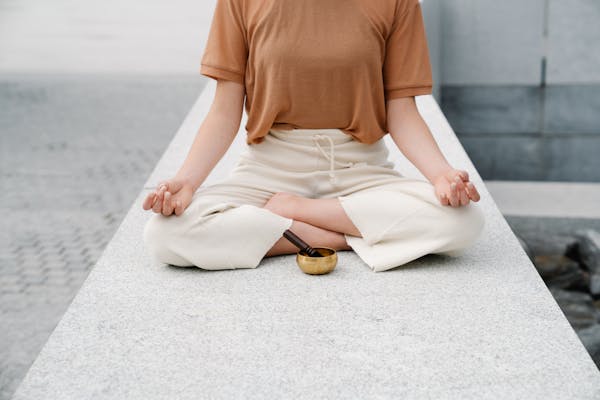Table of Contents
Introduction
Effective Meditation is an ancient practice that transcends cultures for its ability to calm the mind, bring inner peace, and improve well-being. The fast-paced world today finds meditation even more relevant for relief from stress and a journey to greater mindfulness.
This is why it is important to learn about different meditation techniques, no matter whether you are just starting out or deepening your practice.
This blog introduces 10 effective meditation techniques, along with simple steps to help you get underway. Each method has unique benefits and approaches, ensuring there’s something for everyone.

1. Mindfulness Meditation
Mindfulness meditation involves focusing on the present moment without judgment. It is one of the most popular types of meditation and is based in Buddhist traditions.
Steps to Practice Mindfulness Meditation:
Find a quiet place, even at home, where you will be comfortable sitting.
Close your eyes and focus on your breathing. Watch each inhalation and exhalation carefully.
When your mind roams, bring it softly to the breath.
Repeat it daily for 5-10 minutes and eventually extend it.
Benefits are
Improved concentration and awareness
Stress and anxiety decrease
Self-awareness increases, which leads to emotional balance.
2. Focused Mediation
This technique requires focusing on a single point of focus, such as a candle flame, a sound, or a specific object. It is perfect for people who have a wandering mind.
Steps to Practice Focused Meditation:
Select an object or sound to focus on, such as a mantra or soothing music.
Sit comfortably in a quiet space and focus your attention on the chosen focal point.
If your mind wanders, gently bring your attention back.
Benefits:
Enhances concentration and mental clarity.
Brings about a feeling of serenity and stability.
Facilitates the development of discipline in meditation.


3. Loving-Kindness Meditation (Metta)
Loving-kindness meditation, also known as Metta, helps in developing compassion and kindness toward oneself and others. It is a potent method for building positive emotions and eliminating negative ones.
Steps to Practice Loving-Kindness Meditation:
Sit comfortably and close your eyes.
Focus on feelings of love and kindness towards yourself, silently repeating phrases like, “May I be happy. May I be healthy.”
Gradually bring these feelings to loved ones, acquaintances, and even to people whom you find difficult.
Conclude by covering all living beings in your mind.
Benefits
Helps build empathy and emotional strength
It reduces irritation and anger
Strengthens the relationships and overall well-being
4. Transcendental Meditation
Transcendental Meditation (TM) is a very structured technique involving the repetition of a specific mantra to transcend ordinary thought. It is quite well known because it’s so simple and works.
How to Practice Transcendental Meditation:
Select your own mantra or receive one from a certified TM teacher.
Sit in a comfortable position and close your eyes.
Mentally silently repeat the mantra for 15–20 minutes.
Do not force the mantra; allow it to come out naturally.
Benefits:
Induces deep relaxation.
Reduces stress and anxiety.
Boosts creativity and self-knowledge.
5. Body Scan Meditation
Body scan meditation focuses on systematically bringing your attention to different parts of your body. It is an excellent method to unscramble tension and focus on physical sensations.
How to Practice Body Scan Meditation:
Lying or sitting comfortably, close your eyes.
Focus on your toes and gradually move your attention upwards to the remaining parts of your body.
Notice any tension or sensations without judgment.
Spend 20–30 seconds on each body part before moving on.
Benefits:
Relieves physical tension.
Increases body awareness.
Promotes relaxation and stress reduction.


6. Breath Awareness Meditation
Breath awareness meditation focuses on observing your natural breathing pattern. It is a simple yet effective method for achieving mindfulness and relaxation.
Steps to Practice Breath Awareness Meditation:
Sit or lie down in a comfortable position.
Close your eyes and focus on the rhythm of your breath.
Note each breath in and out without trying to alter it.
When your mind drifts off, refocus on your breath.
Benefits:
Reduces the nervous system’s activity
Increases concentration and awareness
Mitigates anxiety and stress levels and clears emotional stagnation
7. Visualization Meditation
Visualization meditation works by using mental imagery for relaxation and some desired outcome. Most commonly it depicts a serene location or presents an expected positive result.
Steps to Practice Visualization Meditation:
Sit comfortably with your eyes closed.
Visualize a serene environment, such as a beach or forest, focusing on the details.
Engage your senses to enhance the imagery—hear the waves, feel the breeze, etc.
Alternatively, visualize yourself achieving a personal goal, embodying the emotions associated with success.
Benefits:
Boosts creativity and motivation.
Reduces stress and fosters relaxation.
Helps with goal-setting and mental clarity.
8. Mantra Meditation
Mantra meditation involves repeating a word or phrase to concentrate the mind and to achieve a sense of calm. Well-known mantras are “Om,” “Peace,” or personal affirmations.
How to Practice Mantra Meditation:
Select your mantra.
Sit comfortably and close your eyes.
Silently repeat in your mind or aloud the mantra chosen.
Allow the mantra to guide you into a deeper state of meditation.
Benefits:
Attains greater concentration and focus.
Offers a feeling of inner calm and spirituality.
It increases positivity and decreases stress.
9. Movement-Based Meditation
Movement-based meditation is a combination of movement and mindfulness, such as yoga, tai chi, or walking meditation. It’s ideal for those who prefer active meditation.
Steps to Practice Movement-Based Meditation:
Select a movement-based activity, such as yoga or walking.
Focus on the sensations in your body as you move—feel your feet on the ground or the stretch of your muscles.
Keep a steady and mindful rhythm.
Benefits:
Increases body awareness and flexibility.
Decreases stress with increased body well-being.
Creates an interdependent mind-body experience.
10. Progressive Relaxation Meditation
Progressive relaxation meditation is often referred to as progressive muscle relaxation. The method aims at tensing and relaxing of various muscle groups in the body in order to release tension and stress.
Steps to Perform Progressive Relaxation Meditation
Sit or lie on your comfortable surface.
Start with your toes. Tense up all those muscles for 5 seconds then let them relax. Continue by working your way up from your body parts.
Notice the difference between tension and relaxation.
Benefits
Relieves physical stress and tension.
Improves sleep quality.
Promotes deep relaxation and mental calmness.
Why Meditation Matters in Modern Life
In our fast-paced, technology-driven world, finding moments of stillness has become a rarity. The pressures of work, family, and personal commitments often leave little room for self-care. This is where meditation comes in.
The Science of Meditation
Studies have shown that meditation can:
Lower cortisol levels, reducing stress.
Improve focus by increasing the prefrontal cortex in the brain
Increase gray matter in the brain for better memory and empathy.
Meditation is not just abstract or spiritual. It has been backed by science, so you can make the most out of it with practical changes in your life for the next few minutes every day.
Tips in Overcoming Common Challenges in Meditation
As a beginner, it is pretty normal to face obstacles when getting started with meditation. These are some common challenges along with their solutions:
Restlessness and Fidgeting:
Solution: Start with very short sessions and focus more on deep breathing to make the body calm.
Racing Thoughts:
Solution: It is pretty natural that the mind will wander. But bring your focus back with no judgment to the technique of your choice.
Lack of Time:
Solution: Incorporate meditation into daily activities, such as mindfulness while commuting or before sleep.
Unrealistic Expectations:
Solution: Meditation is a process, not a cure-all. Acknowledge small victories and appreciate the journey.
Deepening Your Practice
Once you feel more comfortable with the practices described above, you can begin to further your practice.
Setting Intentions: Start each session by setting an intention to cultivate peace, gratitude, or clarity.
Incorporate Technology: Make use of meditation apps like Calm or Headspace for guided sessions and monitoring progress.
Connect with others: Attend meditation classes or online forums to connect with other meditators.
Develop Rituals: Light some candles, play soothing music, or even use essential oils to prepare the atmosphere for meditation.
Integrating Meditation into Other Activities
Meditation is even more potent when combined with other wellness practices:
Yoga: Combine movement with meditation for body-mind awareness.
Journaling: Reflect on your meditation experience by writing down insights or emotions that arise.
Gratitude Practices: After meditation, list three things you’re grateful for to cultivate positivity.
Nature Walks: Practice mindfulness while walking in a park or forest to connect with nature.
Long-Term Benefits of Meditation
When practiced consistently, meditation offers numerous long-term benefits:
Improved Emotional Health: Regular meditation can reduce symptoms of depression and anxiety, promoting emotional resilience.
Improved Attention and Productivity: One trains the mind through meditation in focusing, which enhances productivity at work.
Quality Sleep: Practices such as progressive relaxation and breath awareness calm the mind for good sleep.
Improved Relationships: The loving-kindness meditation increases empathy towards others; thus, improving bonds in society.
Physical Health: One’s blood pressure will decrease, and immunity will increase, and thereby risk exposure to chronic diseases decreases.

Tips for Beginners
It seems impossible, though the simplest tips make it easy.
Start Small: Begin at 5-10 minutes a day and gradually work your way up.
The Habit of Consistency: Meditate at the same time each day.
Comfortable and Quiet Space: Choose a place where one can be without distractions and distractions.
Be Patient: Since nothing goes as expected right away with meditation.
Explore Techniques: Try out various techniques to find what works best for you.
Conclusion
Meditation is an all-inclusive and transformative practice that caters to a wide range of needs and preferences. Through the 10 techniques listed above, you can discover the techniques that resonate with you and integrate them into your daily routine.
Whether you’re seeking stress relief, improved focus, or a deeper connection with yourself, meditation offers endless benefits. Start small, be consistent, and enjoy the journey toward a calmer, more mindful life.
